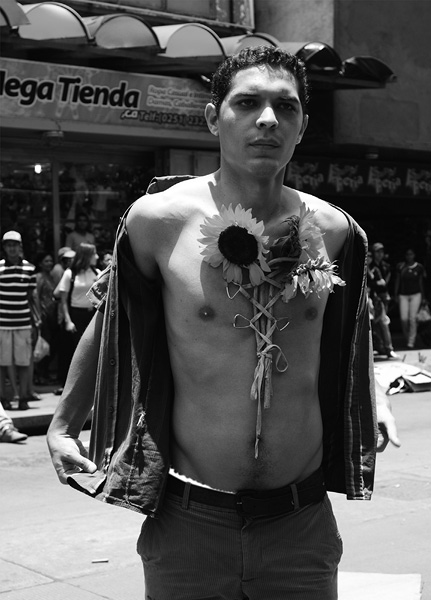
VANITAS VANITATUM
first performed on April 21, 2016
Downtown Barquisimeto, Venezuela
performed once in 2016
CARLOS SALAZAR LERMONT
Chicago, Illinois
156607593c156607593a156607593r156607593l156607593o156607593s156607593z156607593a156607593m156607593u156607593r156607593o156607593@156607593g156607593m156607593a156607593i156607593l156607593.156607593c156607593o156607593m
carloszamuro.blogspot.com
VANITAS VANITATUM
CARLOS SALAZAR LERMONT
Before going into public space, I sewed three sunflowers to my chest, braided them with my shoelaces, and then covered myself with my shirt. I went to the place where I had chosen to perform, a bouquet of three sunflowers protruding from inside the collar of my shirt, and carrying a saw, hammer, three nails, and two long pieces of wood. Once there, I threw the pieces of wood into the middle of the road multiple times. People gathered around as the performance started and I coordinated my movements and actions with the regular car traffic. When there were enough people gathered, I proceeded to remove my shirt, showing how the stems had been sewn into my skin. One by one, I removed them and performed cutting actions with them using a blade and a scalpel, and then nailed them to the wood. After this first part was finished, I walked into the middle of the road and removed the braided shoelaces, leaving them rolled in front of me. Finally, in a single motion, I emptied my pockets, which were full of flower petals, letting these out in a burst of color.
Within art history, Vanitas, a subgenre of still life, tells us that due to the finitude of life, everything related to it is vanity: glory, wealth, power, ambition, the search for knowledge, wisdom, and devotion to a profession. Not even our emotions and feelings, neither the highest nor the most basic, escape this futility. When dying, all these aspects of life remain on the earthly plane, while we are deprived of their enjoyment.
Regarding this subject’s conventional symbology, this performance could be considered an expanded Vanitas. The flower, used as a symbol of that which withers, is a distinctive element of this representative modality which I appropriate for this performance. The sunflower represents admiration and high prospects: looking up at the sun, looking up high. However, aren’t the flowers offered to the deceased also an homage? I take advantage of this ambiguity to generate ambivalent images of life and death drives: the contrast between lacerated skin and the beauty of the flower, the latter being dissected like a corpse.